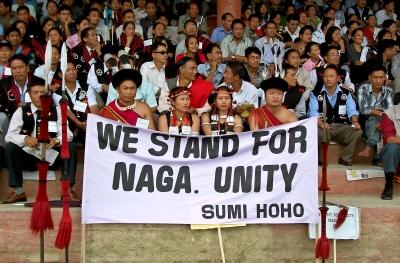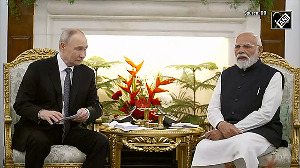 The ongoing vicious game between Delhi and the so-called 'separatist' militias has severely blighted the Nagas' life and gutted their dignity, says Ravindra Narayan Ravi
The ongoing vicious game between Delhi and the so-called 'separatist' militias has severely blighted the Nagas' life and gutted their dignity, says Ravindra Narayan Ravi
Thanks to the media, the country got a glimpse of a recent ironic ding-dong among multiple 'governments' in Nagaland over their competing claims of right to 'sovereign' taxation.
Besides the Government of India, whose presence is marked largely through military cantonments and garrisons in the state, and the feckless state government, there are at least five more 'governments' in Nagaland run by separatist militias. All have their respective governmental trappings and zealously enforce their writs in the state, including their 'sovereign' right to taxation.
Plaintive cries of hapless people flailing under the weight of multiple 'taxation' are sporadically audible, but of no avail.
The swelling popular frustration over unabated rampant extortion spilled over into the streets and sparked statewide protests in June. Its echoes were heard in the state legislature and the national media reported the news.
Unable to cope with rampant extortion by multiple militia groups, the people, risking dire threats, braced up to challenge them. They formed the 'Action Committee Against Unabated Taxation' and under its aegis ventured out into the streets and knocked on all conceivable doors for relief.
Once the national media reported it, the Government of India tamely responded to the popular outcry, largely for the sake of record, with a missive to the Nagaland government reminding it of its constitutional obligations to stop such ‘taxation’ as it would ‘destroy the public confidence in the state’.
The government of Nagaland, as usual, tossed the ball back to the Centre, reiterating that it was for the government to rein in the militias as the latter had been in cahoots with the Centre for endless years and the state government had nothing to do with their affairs.
As for who is ‘destroying public confidence’ in the state, it is for anyone to see. The Centre has been closeted with a handful of separatist militias, sidelining the popularly elected Nagaland government and the legislators, for the last 16 years, purportedly to frame a new social contract with the Naga people that would define their destiny.
The popularly elected legislators are peeved at being kept out of the process as it has put their legitimacy in the dock. The state government, now and then, has been stretching its linguistic ingenuity to fabricate idioms to explain to the Naga people its anomalous predicament. The situation is so bizarre that every Naga holds his tongue tight before opening his mouth in public lest he betrays his frustration and invites the wrath of one or the other militia.
Notwithstanding the clearly spelt-out turfs and responsibilities of the states in the Indian Constitution, it is a fact that the Centre, at the behest of the National Socialist Council of Nagaland, totally sidelined the state government while inking deals with them in 1997.
Subsequent Union governments have done little to correct the anomaly. Fervent pleadings by then Nagaland chief minister S C Jamir to then prime minister I K Gujral to disarm the militias while engaging them were frowned upon and brushed aside.
Flaunting their automatic weapons, armed cadres of the NSCN-IM freely move in towns and villages and intimidate people. Unrestrained, their camps have grown into garrisons for area domination. The security forces have been forbidden by the Centre from venturing within two km of the militia’s camps.
Monitoring of the implementation of the ‘ceasefire ground rules’, framed as if between sovereigns, has been left to an amorphous and toothless body comprising representatives of the Centre, the Naga militias and the NGOs. The state government is excluded from this.
While other militias have been disdainfully indifferent to the mocking spectacle of a blame game between Delhi and Kohima over who should stop the illegal ‘taxation’, the NSCN-IM rebuffed the Centre with a publicly pronounced and widely covered-in-the-media assertion on July 17 -- that they were the ‘government’ and had the ‘legitimate right to levy tax in Nagalim’-- a term they have fabricated to mean the Naga inhabited areas.
‘Unabated’ multiple ‘taxation’ of residents and businesses in Nagaland continues.
The ceasefire ground rules do not prohibit ‘taxation’ by the militias. The militias are technically on the right in their chutzpah. Having emasculated the state government, it is indeed uncharitable for the Centre to teach them lessons in their constitutional obligations!
The separatist Naga militias have been ‘taxing’ the people for long with the tacit connivance of the Centre. Every militia outfit mimics a sovereign government in its trappings and governance procedures. They make public every year with a flourish their annual statements of revenue and expenditures though they reflect only a fraction of the volume of extortion. Their kitties are swelling by the year.
The NSCN-IM’s published budget for 2012-13 was Rs 100 crore, a whopping increase of 30 crore over the previous year's figure.
The long list of stated sources for ‘revenue’ include: ‘FCI/food and civil supplies/Mahatma Gandhi National Rural Employment Guarantee Scheme’@ 5%(Rs 25 crore), ‘Trade and Transport (Rs 17 crore),’Markets and Commercial establishments’ (Rs 8 crore), ‘Service Tax’ (Rs 12 crore), ‘Minerals & Resources’ (Rs 7 crore), ‘ Forest & Environment’ (Rs 7 crore), ‘Naga Army Ration Tax’ (Rs 3 crore) besides several other ‘taxes’ including the unsparing ‘house tax’ that no Naga is exempt from. All this is happening with the acquiescence of the Centre.
What has pushed the hapless Nagas to the limits of desperation now is the ever-mounting multiplicity of ‘taxation’ to which they are being subject. It has been caused by amoebic multiplications of militia outfits during the period of ‘ceasefire’, their growing avarice and increasing audacity to control ever more and more aspects of the peoples’ day-to-day life.
The de facto retreat of the Centre from Nagaland, except for passive military garrisons where the tricolour flies, and the state government’s pretended isolation from the affairs of the militias on the pretext that they are not in the ‘peace-making’ loopm, have given the militias unrestrained free play in the state.
The Naga ‘revolution’, over the years, has degenerated into a comic spectacle in which the ‘revolutionaries’ are gainfully closeted with their arch-enemy, the Indian State, while they remain unsparingly brutal with the Naga people should they ever demur on their writs, including whimsically determined ‘taxes’.
Constantly oppressed people occasionally burst out on the streets and cry out loud, seeking a catharsis. The Union and the state governments have trashed their cries so far. There is no hope that the present outburst will meet a different fate.
Dr Manmohan Singh, who owes his seat in Parliament to the north-east and is arguably the prime minister with the longest continuous term in office after Pandit Jawaharlal Nehru, squandered the historic opportunity to fix the region.
He abandoned the Nagas to a cynical game of footsie between his interlocutors -- former bureaucrats -- and the proliferating Naga militias. The interlocutors have not risen above mere rent-seekers.
K Padmanabhaiah, a former home secretary and effectively the first interlocutor, survived for some 12 years in this cast. Setting the course for Naga 'peace talks' on a perverse trajectory has been his singular contribution. He ignored the popular Naga sentiment and bought into the contentious rhetoric of the NSCN-IM.
Not only that, he mischievously amplified them to successive prime ministers and home ministers. He indeed proved himself a successful marketing agent for the NSCN-IM in selling its larger-than-life profile to Delhi. His successor, R S Pandey, is carrying on the legacy for the last four years.
Both the interlocutors, quintessential bureaucrats ever cautious to avoid controversies, reflexively inimical to initiatives and amply adept at the art of self-perpetuation, are to a great deal responsible for the dystopia in which the Naga society finds itself today.
Both these gentlemen encouraged a gullible Dr Singh to believe that 'peace' was just within his grasp at the next round of 'talks'. While 'peace' remains a holy grail, the hapless Nagas continue to shed blood and tears under the mounting weight of multiple ‘governments’.
Notwithstanding grievances, genuine and imagined, Nagas by and large do not suspect their Indian citizenship today. Their simple desire is to live a dignified and honourable life. The ongoing vicious game between Delhi and the so-called ‘separatist’ militias has severely blighted their life and gutted their dignity. They are crying for redemption. The Government of India must mend its ways.
Ravindra Narayan Ravi is a retired special director of the Intelligence Bureau.
Image: Naga tribesmen during a protest march in Kohima





